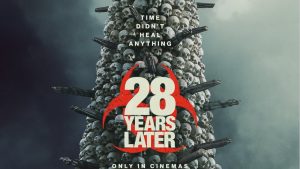THE wait has been worth it.
It’s been 23 years since Danny Boyle and Alex Garland re-defined the zombie sub-genre of horror with 28 Days Later.
Yes, I know there had been fast zombies on screen prior, but 28 Days Later was the first film to give us a new species explained by the spread of a ‘rage’ virus.
The second instalment, 28 Weeks Later, didn’t involve the original creators but many people feel is now an all-round better film, featuring one of the greatest opening sequences in cinema history.
Combine that with the wealth of zombie-based film and television material that has followed, and there was a lot of expectation for the return of Boyle, Garland and cinematographer Anthony Dod Mantle to the fold.
They don’t disappoint.
While 28 Years Later does follow many of the tropes done finely in television series like The Walking Dead and The Last of Us, it also creates others through imagery and story-telling achieved with dazzling technical skill.
The film was reportedly mainly shot using an iPhone camera, providing some unique points of view, but obviously a range of other digital and film cameras and drones were also used. The result is a constantly changing screen-scape that commands the attention.
The opening sequence, while not matching that of 28 Weeks Later’s gut punch, is still a thrilling and visceral experience which includes a portent to events much later in the film.
You’ll recall the final scene of 28 Weeks Later in which the infected had escaped containment in London and arrived to wreak havoc in mainland Europe.
That scenario isn’t true for Boyle’s third film which is instead set in a future Britain that appears to have been totally over-run but remained isolated from the rest of the World.
In the Scottish Highlands pockets of the surviving population have created communities living in fortresses that keep out the infected roaming the countryside.
One community has become a veritable island within an island, established on ground surrounded by water that can only be reached by one narrow causeway at low tide.
Among the inhabitants are Jamie, his wife Isla, who is suffering from a mystery illness, and their 12-year-old son Spike.
As part of Spike’s coming-of-age initiation, he and his father leave the compound to hunt for infected that will become Spike’s first kill.
It is here that Boyle and Garland introduce two new forms of infected – an ultra-slow version that can only crawl through the forest, presented brilliantly with an over-the-shoulder camera view, and a large alpha male that appears to have evolved to become a tribe leader.
The trip descends into a heart-in-mouth fight for survival from which the pair only just make it back to the safety of the compound.
But this is only the first half of the film. In the second, the story re-focuses to the relationship between Spike and his mother who leave the compound by themselves in search of a doctor who lives in the forest and may be able to cure Isla’s illness.
This second half becomes as much an emotional story, with several character threads and themes in play, as it also continues to be a pure horror thriller with the Alpha making its return.
As is usual with a Boyle/Garland combination, there is excellent across-the-board casting with Aaron Taylor-Johnson and Jodie Comer as the parents and Ralph Fiennes as the Colonel Kurtz like doctor.
But the best performance is from young Alfie Williams as Spike upon whose shoulders much of the film’s emotional weight is carried.
Unfortunately, the ending of the film is divisive and will likely annoy many, including myself.
I did hear one critic suggest it’s better to look at the final sequence as a post credits extra. That’s fine, and I will definitely approach a re-watch in that frame of mind, but it’s not how Boyle wanted it.
These are pretty minor quibbles in another tour de force of film-making.
A sequel, 28 Years Later: The Bone Temple, was shot simultaneously and will be released in January 2026.
Watched at the cinema.
